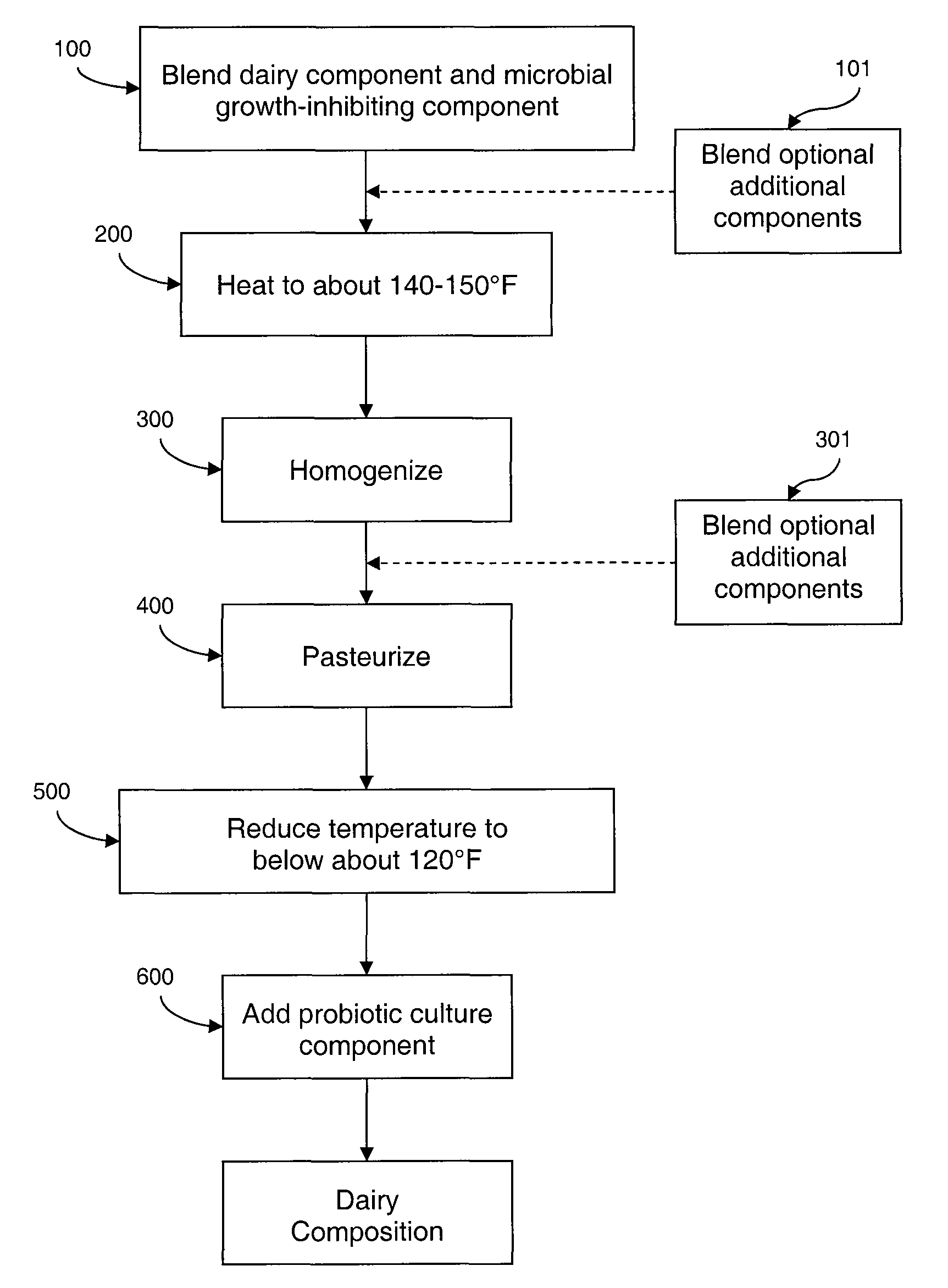Dairy composition with probiotics and anti-microbial system
a technology of probiotics and compositions, applied in the field of dairy compositions, can solve the problems of high calorie consumption, incompatibility between low ph and sour yogurt, and increased susceptibility to pathogenic and/or spoilage, and achieve the effect of increasing the susceptibility of pathogenic and/or spoilage and increasing the number of undesirable effects
- Summary
- Abstract
- Description
- Claims
- Application Information
AI Technical Summary
Benefits of technology
Problems solved by technology
Method used
Image
Examples
example 1
[0035]The following example demonstrates the ability of inoculated probiotic cultures to remain substantially viable in the presence of sorbic acid. Dairy product Samples 1-4 were prepared in accordance with the present invention having the formula shown in Table 1A.
[0036]
TABLE 1AIngredient% by weight of compositionSkim milk75.6Butter3.6WPC 802.45Inulin2.3Sucrose13.0Food Grade 5N HClAn amount effective to achieve afinal pH of about 5.0-5.9 (generally ~0.25)Starch2.0Gum0.5Flavor0.2Sorbic acid0.08Probiotic culture B. lactis9 × 106 cfu / gBI-04 (Danisco)
[0037]The pH of the Samples 1-4 was adjusted to the range of about 5.0 to 5.9, as set forth in Table 1B. The samples were stored for 8 weeks at refrigerated temperatures (i.e., less than about 45° F.). After that time, all four samples exhibited beneficial viable probiotic culture levels above about 1×105 cfu / g. The results are shown in Table 1B.
[0038]A comparison sample, Sample 5 was prepared having the same formula as Samples 1-4, but w...
example 2
[0042]The following example further demonstrates the ability of inoculated probiotic cultures to remain substantially viable in the presence of sorbic acid. Dairy product samples 6 and 7 were prepared according to the formula shown in Table 1A except that, the probiotic culture B. lactis BI-04 (Danisco) was replaced with a different culture. In Sample 6, the probiotic culture Bifidobacterium lactis BB-12 (Chr. Hansen) was added at a level of about 5.4×106 cfu / g, and in Sample 7, the probiotic culture L. reuteri (BioGaia) was added at a level of about 1×107 cfu / g.
[0043]The samples were adjusted to a pH of about 5.9. The samples were stored for 9 weeks at refrigerated temperatures (i.e., less than about 45° F.). After that time the samples exhibited beneficial viable probiotic culture levels above about 1×105 cfu / g. The results are shown in Table 2. The amounts shown in Table 2 are cfu / g unless stated otherwise.
[0044]
TABLE 3SamplepHT01 wk3 wks6 wks9 wks65.95.4 × 1063.5 × 1061.4 × 1068...
example 3
[0045]The following examples demonstrate the inhibition of pathogenic microbe growth in sorbic acid-containing dairy product samples as well as the effectiveness of probiotic cultures as a secondary barrier against such growth. Dairy product samples 8-10 were prepared according to the formulas shown in Table 3.
[0046]
TABLE 2SamplepHT01 wk3 wks6 wks9 wks65.95.4 × 1063.5 × 1061.4 × 1068.3 × 1051.6 × 10575.92.0 × 1071.3 × 1071.2 × 1075.6 × 1063.4 × 106
[0047]A pathogen growth challenge study was conducted on the samples whereby C. botulinum was inoculated into the samples as a proteolytic suspension of 1.5×105 spores / ml and allowed to grow stored at 86° F. for 7 days. The initial proteolytic botulinum inoculum count (EYA) was 160 spores / g in the inoculated samples and C. botulinum toxin were tested by standard assay procedures as outlined by the FDA. The results for Samples 8-10 are shown in Tables 4-6, respectively.
[0048]
TABLE 4Sample 8T01 day2 days3 days4 days5 days6 days7 dayspH5.75 5...
PUM
| Property | Measurement | Unit |
|---|---|---|
| pH | aaaaa | aaaaa |
| temperature | aaaaa | aaaaa |
| temperature | aaaaa | aaaaa |
Abstract
Description
Claims
Application Information
 Login to View More
Login to View More - R&D
- Intellectual Property
- Life Sciences
- Materials
- Tech Scout
- Unparalleled Data Quality
- Higher Quality Content
- 60% Fewer Hallucinations
Browse by: Latest US Patents, China's latest patents, Technical Efficacy Thesaurus, Application Domain, Technology Topic, Popular Technical Reports.
© 2025 PatSnap. All rights reserved.Legal|Privacy policy|Modern Slavery Act Transparency Statement|Sitemap|About US| Contact US: help@patsnap.com

